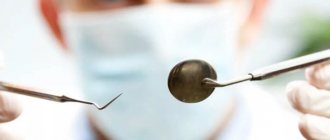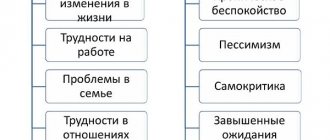About five percent of the world's population experiences panic attacks. Usually these are young people between the ages of twenty and thirty. Moreover, women are more susceptible to the disease. Panic is a normal reaction of the body to stress, but what are the reasons for its appearance, since there seem to be none?
A panic attack causes a powerful release of adrenaline, a hormone that involves preparing the body for an extreme situation and reacting to it, such as flight or fight. Breathing and heart rate increase, hyperventilation of the lungs occurs, which leads to dizziness, numbness and tingling of the legs and arms.
This is how the body usually reacts to sudden danger, this is normal. Thus, a panic attack is a malfunction of the body that causes the “emergency mode” to turn on, although this is not necessary.
More about panic attacks
Panic attacks are a sharp increase in anxiety and fears that are generated by an internal state and are not related to the current situation. A typical form of panic fear is accompanied by various vegetative-vascular and motor manifestations, such as:
- pronounced feeling of anxiety;
- fear for your health and life;
- cardiopalmus;
- increased sweating;
- sudden changes in blood pressure;
- trembling in the body;
- lump in throat;
- feeling of lack of air;
- abdominal pain and gastric disorders.
Panic attacks very rarely (about 1%) are a sign of serious diseases, such as heart defects, pheochromocytoma, oncology, etc., in the vast majority of cases they are associated with the psycho-emotional sphere and the autonomic nervous system. It is through the autonomic nervous system that all the mechanisms of panic attacks are realized.
Photo on Unsplash
An atypical form of a panic attack, the so-called “panic without panic,” can be manifested by temporary loss of hearing, voice, vision (a veil before the eyes), a person’s sense of taste and smell disappears, and motor skills are turned off. Such symptoms are usually observed in serious procedural mental disorders.
Signs of a panic attack
It's surprising that not everyone who suffers from panic attacks knows what it is. It often happens that a panic attack is mistaken for some kind of heart disease, because they have a number of similar symptoms.
A vegetative crisis (an alternative name for a panic attack) can begin with increased heart rate, chest pain, and a feeling of shortness of breath. Patients attempt to relieve symptoms with the help of heart medications, but in this case they will not have the expected effect.
Photo on Unsplash
Other signs of a crisis include trembling hands, dizziness, excessive sweating, chills, a feeling of unreality of what is happening, impending loss of consciousness, inexplicable uncontrollable fear. At the same time, the presence of fear is not at all necessary: at the moment of an attack there may not be a panic attack, but instead, sadness, tearfulness or aggression are felt.
The duration of a panic attack can vary. The average duration is from 15 minutes to half an hour. Frequency of attacks: from several episodes a day to a couple of times a month. In principle, this is not a dangerous phenomenon, but there is a risk that panic attacks can have a bad effect on the psychological state, which will only increase their number.
Get to know the essence
As you know, a panic attack occurs groundlessly, without a real threat. She can find her carrier at home watching TV, at work or in her bed at night.
Its main driving factor is fear: death, hopelessness, fainting or having a heart attack. These are the thoughts that visit a panicker at the peak of an attack. They, in turn, trigger a pathological reaction in a circle until the psycho-emotional stress decreases. At the moment of such a cyclical process, there is a certainty that it will never end.
Where does this fear come from? It is provoked by a neurochemical imbalance: the amount of stress hormones (adrenaline, norepinephrine) prevails over serotonin, the hormone of happiness. This happens for various reasons: chronic stress, overwork, sedentary lifestyle, internal conflicts, bad habits, etc.
It is the feeling of fear, fueled by adrenaline, that causes a number of painful physiological symptoms. Among them are suffocation, chaotic fluttering of the heart muscle, profuse sweat, trembling, dizziness. All this is the result of a sharp narrowing of blood vessels and excess oxygen in the blood. Extreme fear drives a person to madness. He does not understand where he is, the world around him seems blurry and unclear.
The fight against a panic attack, as a malicious disturber of a person’s peace, begins when he realizes one fact: this condition is not a sign of a physical illness (if you do not have concomitant diseases). It is impossible to die from it, your heart will not stop, you will not suffocate from lack of air, you will not even faint.
Take and analyze your attack. When it ends, all symptoms go away and your body works smoothly again. The heart does not jump out of the chest, breathing is smooth, blood pressure is normal.
Surely you have already undergone all kinds of examinations, checked every organ, visited all the specialists. If their diagnosis is unanimous and confirms that you are physiologically healthy, shift the focus in the other direction: look for the problem in your head, in your mental state. Understand that a panic attack is the result of a mental imbalance, so it is not the body that needs to be treated, but the soul.
Causes of panic attacks and risk factors
Panic attacks can be caused by any illness or experience. Most often they occur in people whose lives include at least one of the following factors:
- lack of physical activity;
- caffeine abuse;
- bad habits;
- suppression of emotions within oneself;
- lack of proper sleep and rest.
The tendency to panic attacks develops under conditions of an accelerated pace of life and chronic stress. Sometimes the condition develops against the background of mental disorders, but can also accompany coronary heart disease, mitral valve prolapse, thyrotoxicosis, depression, post-traumatic disorder, obsessive-compulsive disorder and other diseases.
Stages of panic attacks
There are three stages of a panic attack:
- initial – warning signs of a panic attack appear. This may be some anxiety, uncertainty, heaviness in the head, inexplicable discomfort;
- expanded - a feeling of anxiety and fear appears, which steadily increases. It is at this stage that the main symptoms affecting the cardiovascular and respiratory systems occur. When anxiety and fear turn into panic, a person can no longer control himself;
- final - a feeling of lethargy, fatigue and weakness appears.
Foreplay can last up to half an hour, this time is quite enough to provide assistance and get rid of a panic attack. Panic, when a person is in a state of derealization, lasts on average about 30-40 minutes, maximum an hour. After a panic attack ends, it sometimes takes a day or more to fully recover and get rid of the consequences.
Photo by Max Nelson on Unsplash
Most often, panic attacks occur in the evening and at night, which can cause chronic insomnia, which in turn is a risk factor for the development of a panic state.
Symptoms of panic attacks
Symptoms characteristic of panic attacks are conventionally divided into two groups: physical and mental. The first group includes bodily sensations, and the second – mental ones.
Mental symptoms of panic attacks:
- Fear of death;
- lump in the throat;
- a feeling of unreality of what is happening;
- pre-fainting state.
Physical symptoms of panic attacks:
- Frequent heartbeat;
- hot flashes;
- chills;
- increased sweating;
- dry mouth;
- diarrhea;
- chest pain;
- numbness of the limbs;
- nausea and vomiting;
- weakness;
- dizziness.
Sometimes a panic attack follows an atypical scenario in the absence of fear and other manifestations. Instead, one of the body’s functions is temporarily disrupted - vision is lost, the gift of speech is lost. Another name for such attacks is hysterical neurosis.
Diagnosis of panic attacks
Even a doctor cannot always separate the symptoms characteristic of a panic attack from the manifestations of another disease. To clarify the diagnosis, the skin is examined, reflexes are checked, and the abdomen is examined.
Photo by Ani Kolleshi on Unsplash
The main methods of examination are electrocardiography, listening to the lungs and heart, measuring pulse and oxygen saturation. A panic attack is diagnosed based on a set of data obtained.
What to do during a panic attack
- Autotraining . The patient must tirelessly convince himself during a panic attack that this is a temporary phenomenon, its symptoms are not dangerous and will soon pass.
- Technique of switching attention . A panic attack can be easily dealt with if you stop thinking about it. This can be easily done by simply switching your attention to something. Slowly count to 50, do simple addition or multiplication in your head, talk to someone about an abstract topic.
- Normalization of the respiratory process . A person often experiences shortness of breath during a panic attack. This happens due to an imbalance in the gas balance in the blood. It needs to be normalized as soon as possible. To do this, you need to press a paper bag very tightly to your nose and mouth, and slowly inhale and exhale into it for about thirty seconds. In the absence of a package, you can use folded palms.
Train your mindfulness
Mindfulness is the ability to notice what is happening in and around you.
Panic attacks often lead to a feeling of unreality, out-of-body, detachment from one's own body and from the world. Mindfulness helps cope with a panic attack and the first signs of its approach.
How to deal with panic attacks? Focus on your body, look at it or imagine with your eyes closed: how your feet touch the floor, how your clothes touch your skin, mentally move to the tips of your fingers.
To distract yourself, you can focus your gaze on familiar objects around you - a glass with pens and pencils, a plant on the window, a pattern on the wall or on the floor, and so on.
Medications to treat panic attacks
Drug treatment of panic attacks includes the use of the following types of medications:
- tranquilizers;
- neuroleptics;
- antidepressants;
The main disadvantage of these methods is the instability of the effect after taking a course of medications. For some, after a year, for others even earlier, relapses of panic attacks may occur. Doctors attribute this to the fact that the patient has not developed the skills to manage emotions in stressful situations.
Treatment
Increased self-esteem
One of the areas of treatment for panic attacks is to work on increasing self-esteem and self-confidence. And also on the ability to be critical of the personality of your parents. The ability to criticize the upbringing that was given to him by his parents will allow a person to move forward, working on his personal characteristics and developing his own individuality, rather than freezing in place, afraid to change what the adults who are significant to him have created.
In the process of psychotherapy, a person goes through the following stages:
- Understanding that parents are not perfect, since they are ordinary people;
- Protest against the methods of education that parents used and against the parents themselves;
- Separation - mental separation from parents;
- The beginning of the formation of one's own personality;
- Acceptance and gratitude to parents for doing everything they could and as best they could to raise their child.
- Accepting yourself as you are and starting to build your life in accordance with your own preferences.
Disclaimer
It is worth noting that all the procedures described in this section are best carried out under the supervision of a psychotherapist or psychologist. Or at least visit him periodically and tell him about the work done in order to receive the necessary recommendations and make adjustments to your wellness actions.
Self-treatment
Simultaneously with working on self-esteem, it is necessary to carry out procedures that help reduce anxiety.
Helps reduce anxiety:
- Breathing exercises;
- Sports activities;
- Autogenic training;
- Relaxation exercises.
Medicines
Also, if a psychiatrist or neurologist prescribes medications, then you should not neglect them, just as you should not get carried away.
Medicines should be treated as an auxiliary tool that facilitates psychotherapy and the dosage of which should be constantly reduced as psychotherapeutic treatment progresses.
Psychotherapy
Psychotherapeutic treatment can be carried out in various directions:
- Cognitive behavioral therapy. It will help you develop the habit of not being afraid of panic attacks.
- Body-oriented therapy. Will teach you to understand the body signals that precede panic attacks, as well as manage bodily reactions to reduce symptoms.
- Hypnotherapy. It will help create new internal attitudes that promote mental immunity, helping to predict and prevent panic attacks.
In addition to all of the above, a psychotherapist will help you understand the causes of PA. During psychotherapeutic sessions, it will become clear what underlies this disorder and what events or series of events led to it.
Complex treatment
In order for the treatment of panic attacks to be successful, a certain number of vectors must converge:
- A doctor prescribing medications must respect psychotherapeutic methods of treatment and understand that medications do not fully treat a mental disorder, but only relieve certain bodily symptoms and adjust the chemical and hormonal background of the body. As soon as a person stops taking them, his body stops producing the chemical elements necessary to maintain health. Therefore, in the long term, medications lead to addiction.
- The psychotherapist should also not sabotage drug treatment, but should enter into collaboration with the doctor to discuss the results of drug-psychotherapeutic treatment, as well as determine and adjust the dosage of medications.
- The third condition is the cooperation of the patient himself with the specialists treating him. He should try to be honest with them and follow all their instructions. In other words, the patient must feel responsible for what happens to him and not shift it to the people treating him.
Treatment results
If client-doctor-psychotherapist cooperation is established, then a decrease in the number of panic attacks will gradually be observed, as a result of which they will stop completely.
As treatment progresses, the dosage of medications should be reduced until they are completely discontinued. All this should happen against the background of psychotherapeutic treatment.
As general anxiety decreases, both phobias and panic attacks will go away, that is, complete physical and mental recovery will occur.
Author: Dmitry Malin - clinical psychologist
Consequences of a panic attack
Constantly recurring panic attacks can lead to neurotic personality changes, when a person develops internal blocks on a subconscious level that do not allow him to receive full and effective help. When a person gets used to his neurosis, any attempts to bring him out of this state encounter active resistance. This can lead to loss of ability to work, social maladjustment and disability.
If the attacks are pronounced and occur very often, the person becomes antisocial. In this case, to get rid of them, you need the help of a psychiatrist or psychotherapist and treatment in a hospital setting.
Stop the attack with medication
Drugs from the group of tranquilizers (anxiolytics or anti-anxiety drugs) help stop a panic attack if you take the pill at a time when it is still in its infancy.
Tranquilizers cannot be taken by everyone; they are sold by prescription, so they must be prescribed by a psychiatrist or psychotherapist.
Panic attacks. Why don't pills help?
Is it possible to go crazy from panic attacks?
Manifestations of a panic attack are often a feeling of unreality of everything that is happening around, disorientation in space and time, loss of control over one’s actions, deeds and the world around us. All these symptoms are often accompanied by a fear of going crazy.
Many people who have survived an attack do not know how to get rid of panic attacks forever, and are afraid of developing psychosis, schizophrenia and other serious mental disorders. To dispel these fears, you need to know the nature of panic attacks.
Photo by Ian Espinosa on Unsplash
During a panic attack, the rhythm of breathing involuntarily changes, it becomes more frequent, which is a natural protective reaction of the body - preparation for fight or flight in any dangerous situation. As a result, excessive amounts of oxygen enter the blood. This leads to acidification and dilation of brain vessels, which, in turn, causes a feeling of derealization.
This condition increases the fear of the possibility of dying or going crazy. Every patient must understand that this is a natural reaction of the body, in which no changes occur in the central nervous system, and all fears are only subjective sensations that have no neurophysiological basis. A qualified psychologist at our center can explain all this to him.
How to behave during the interictal period
Therapy for panic attacks during periods of calm includes several key points. The main thing is to get rid of stress, traumatic situations and internal tension.
It is very important to increase the body's ability to withstand stress. A set of measures will help with this .
- Learn to control your emotions and actions, take responsibility for them. To do this, analyze situations, your decisions, why you acted this way and not otherwise, what would have been better for you to do in this case. Write down your thoughts. If you have made wrong actions, review them and build a model of correct behavior. Now you know how to behave in a similar situation.
- Let more positive emotions into your life. Watch pleasant, funny films, do what you love more often, communicate with positive people. Try to be alone less.
- Stop making derogatory remarks about yourself. Praise yourself for your achievements, accept your shortcomings and work on them. Don't make comparisons between you and other people. Pay attention to yourself, look after yourself.
- Try not to mentally return to traumatic situations that happened to you in the past. To avoid reliving negative emotions. Try to remove all things that may remind you of this event.
- Find something you like. Direct your energy to creativity, not to dark thoughts.
Meditation will help you relax. It will relieve not only emotional tension, but also muscle tension. There are professional practices that require special training and knowledge of techniques.
At the everyday level, you can meditate by turning on relaxing music and taking a comfortable position. The best way to do this is to lie down. Close your eyes or focus on one object. Breathe deeply, evenly and mentally repeat the pre-prepared phrases: I am calm, my fear is receding, I have everything under control, and any other phrases adapted to your condition.
How to get rid of panic attacks and fear
To get rid of panic attacks, it is necessary to observe a strict sleep and wakefulness regime, stop using various stimulants, normalize the psycho-emotional state, and also receive rational and competent psychotherapeutic help. It includes:
- Cognitive training will allow the patient to understand what a panic attack is and why he should not be afraid of it - although the sensations are very unpleasant and sometimes quite scary, he will not die from them or become disabled. Understanding and awareness of this is the key to successful treatment and getting rid of attacks.
- In case of severe panic attacks, when correction of the condition is required, it is worth using anti-anxiety drugs - antidepressants.
- Emotional and mental conflicts are usually programmed in childhood. To get rid of panic attacks, you need to find out their root causes. By learning to manage your thoughts, you can learn to manage your fears. We will help you with this.
How to behave during an attack
The alarmist should be able to determine the onset of an attack. Muscle twitching appears, the legs become as if they are made of cotton, and coldness passes through the body. Shortness of breath appears, consciousness narrows, attention is fixed at one point.
When you feel the first warning signs, try to leave the room where you were attacked. It's best to go outside. You can take out your phone and call someone, distract yourself with information on the Internet.
If you cannot change your location, for example, this happened on a bus, try to switch your attention. The best way is to count any objects you find at hand:
- buttons and other clothing items;
- trees;
- machines, and you can use different variations. How many red or black cars have passed? How many cars move in one direction, and how many in the other;
- pillars;
- if you are in a crowd, count how many men and how many women you see;
- windows in houses.
Take one position. Stand, or better yet, sit down. Take a comfortable position. Lean on something solid and stable.
You can distract yourself by changing your bodily sensations. Pinch, lightly pull the hair, hit yourself with little force. Try to actively change your facial expressions: puff out and deflate your cheeks, pinch and spread your lips in a smile, close and open your eyes.
Perhaps, instead of a frozen pose, physical exercise will bring you out of horror. Squat, jump, you can run lightly, imitate jumping rope.
Another way to shift attention is to sing a song, out loud and loudly, or recite a verse also loudly and with expression. The text should be positive and not evoke gloomy emotions.
Actress Megan Fox discovered an interesting method of dealing with a panic attack. Usually they started on the plane. After she started playing Britney Spears songs and listening to them in headphones throughout the flight, the attacks stopped.
Be sure to control your breathing. You need to eliminate excess oxygen in the blood. To do this, try to breathe deeply. Take a deep, long breath and a loud, long exhale. Try to get all the air out of your lungs.
The most effective way to restore respiratory calm is to breathe into a bag or folded palms.
If a panic attack strikes you at home, take a contrast shower.
Of course, if the attack happened to a person for the first time, it will be difficult for him to control it. But, having learned how to deal with it, if it happens again, he will give it a worthy rebuff.
Treatment and prevention of panic attacks
Treatment of panic attacks should be aimed at eliminating the source of the attacks and smoothing out the unpleasant symptoms. The optimal way to combat panic attacks is a competent combination of medications and non-drug therapy. The main methods of treating attacks:
- taking antidepressants as prescribed by a doctor;
- psychotherapy;
- physiotherapeutic procedures (MDM of the cerebral cortex, electrosleep, chromotherapy, aromatherapy, reflexology);
- relaxation massage;
- physiotherapy.
Additional treatment of panic attacks is practiced with herbal decoctions with a calming effect - infusions based on mint, lemon balm, chamomile, motherwort, etc. It is necessary to reduce the amount of stress to a minimum. Spicy foods, strong tea and coffee, and alcohol should be excluded from the diet.









